"Мчится дальняя дорога,
осталось нам не многоИ с попутным нам ветром,
мы ждем яркого светаТот свет в конце туннеля,
нас манит к нашей целиЧерез рвы и преграды,
мы ждем больше награды.
Солнышко лучистое, небеса так чистыОсвещают нам дорогу с высока"
Дорога (2009), МакSим
I was all ready to leave Chamba before the night was. Quietly placing my key at the receptionist's counter, I tread softly out of the guesthouse and walked the twenty or so paces to the town's bus station where about a hundred people swaddled in their travelling blankets were waiting blankly (some from the evening before) to depart. My first challenge of the newborn day was to ascertain which bus I expect to board by repeating the name of my destination emphatically to strangers whose command of English starts and ends at, "No English." The air was chilly so I amused myself by huffing and sighing misty breaths from the warmth of my chest. On the foggy main street, a ritual procession of Hindu trumpeters, pipers, cymbalists and mantra mumblers marched in and then marched out of earshot again. It was far from six and farther still from true daylight.
That day, my plan was to visit the 1500 years old township of Bharmour situated about 65 kilometres east of Chamba. The ancient erstwhile capital of the region is nestled on the side of a mountain at the altitude of about 2195 metres, overlooking "the edge of a seemingly bottomless valley" according to the tatty photocopied pages of my guidebook. It's a three-hour journey by bus. In theory.
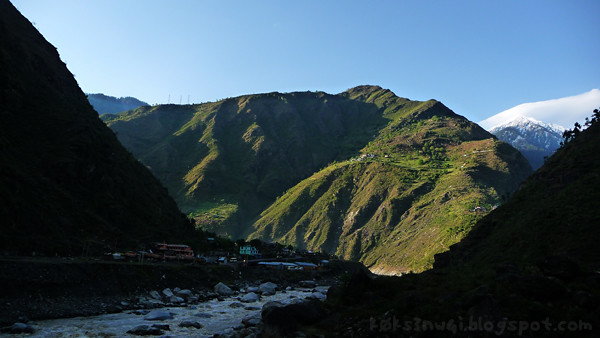 |
| The breakfast stop at the village of Rakh after the first half-hour. |
The road is a thrilling and treacherous one. It's narrow, serpentine and crumbly at parts. There's a constant danger that it might just give way under the weight of say, a bus, and plunge it into the mighty Ravi River below. The other threat loomed overhead in the form of fractured shale mountains known to moodily unload cascades of rocks at a moment's notice. By the way, I am not recounting these possible perils to romanticise my journey or make me appear more intrepid that I really am. I actually experienced several of these hazards when I was on the road to Bharmour. Honest-to-goat.
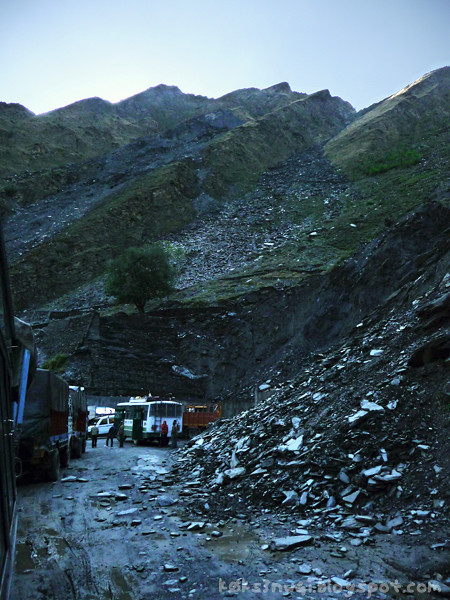 |
| Landslid and rockfallen before the first hour of the journey was even up. |
I have never felt such an immediate threat to my life as when I had to get off the bus and make my way past the debris on foot, noticing only after I was halfway through that stray shards of razor-sharp shales were still tumbling down the mountainside! The landslide was ongoing! Without so much as a yelp of panic, I sprinted the rest of the way across before one could cleave my skull open and decorate the countryside with my tofu.
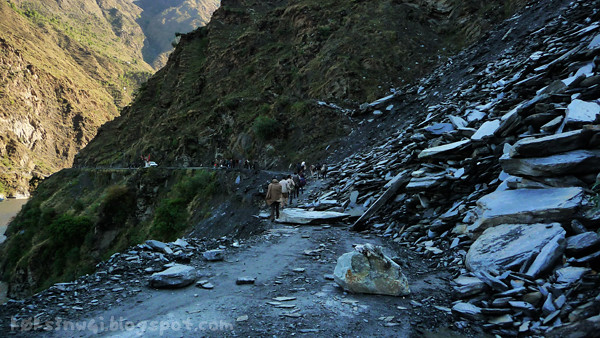 |
| Check out how massive the rocks are compared to the puny wayfarers. |
Being unable to speak with any of my fellow passengers due to our pesky language barrier, I assumed that there would be relay transportation on the other side, but the walk to it was unexpectedly long. Apparently, a similar obstacle had also blocked the road ahead of us, creating a few kilometres of pedestrian-only stretch.
I honestly saw it as a stroke of good luck. It allowed me to sightsee and take photographs at my leisure, and the Himalayan scenery there was a grand affair to behold; so majestic that it gave me chills.
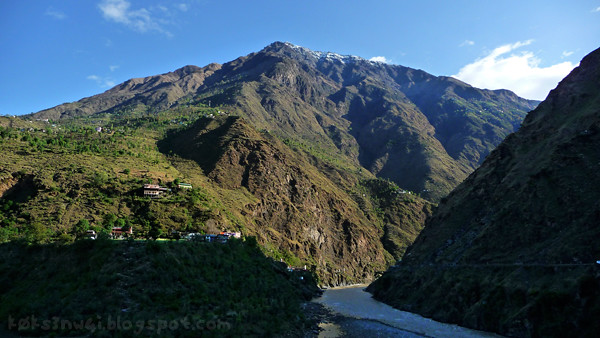 |
| This is what I live for. This, and sushi. |
 |
| A little rain cataract. |
 |
| Imagine a segment of that rock face sliding down and crushing the people below. |
After my unexpected but refreshing hike, I boarded the second bus and was on my merry way again - for about forty minutes. Another bountiful tandem collapse of shale and soil had rendered the road impassable for anything wider than a bicycle, and once more everybody had to get down and get a move on. The fact that no one grumbled or was at a loss for what to do made me think that such delays are so routine that the people here hardly notice them anymore.
My next ride was a jeep which was stuffed about a dozen people past safe capacity - that's normal hereabouts. Lucky for me, I got to ride shotgun, allowing me to continue basking in the magnificent views and snap more pictures. I don't recommend this for those who are afraid of heights or are generally faint of heart because the jeep cuts really close to the edge. There's a very real fear of being tossed clean out of the vehicle and down, down, down into the white waters below should the jeep hit a particularly nasty pothole or brake abruptly. Compounding the thrill was our speedster driver who saw no reason to go easy on the accelerator as he snaked with reckless abandon through the precarious mountain road.
 |
| Waterfall down a sheer cliff. |
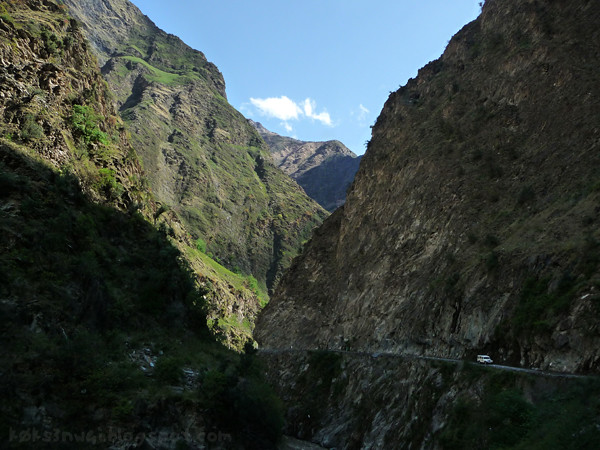 |
| That jeep there should give you a sense of scale. |
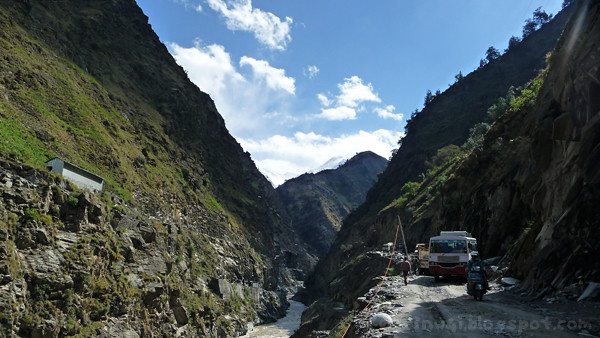 |
| Believe it or not, the road to Bharmour is a two-lane highway. |
 |
| The river Ravi, which accompanies the road two-thirds of the way. |
The subsequent turn of events may be a wee bit hard to swallow but I assure you it did happen. We were ejected from the jeep due to yet another pile of rocks and soil standing between us and Bharmour. I knew the tempestuous rainstorm which paid the Chamba Valley region a visit the night before was no drizzle but still I wouldn't have imagined that it was strong enough to smash the stony hills here to smithereens. Still, I suppose I ought to be thankful that this time, there was no need to walk very far to hitch a ride on the next bus.
Eventually, I arrived in the village of Kharamukh which marks the end second third point of the barely functional highway to Bharmour. Here, the road crosses a thin bridge spanning the Ravi, and ascends a few hundred feet before disappearing into what looked like a crack in the mountain range.
 |
| At the confluence of the Budhil and the Ravi. |
The last third of the Bharmour Road runs along the side of a tributary of the Ravi River called the Budhil which was responsible for cutting the canyon out over millions of years. I didn't think it was possible but the landscape on this leg of the journey is even more awe-inspiring than the part before. Sighing, I wished the bus would stop so I can go down, stretch my legs, and drink it all in.
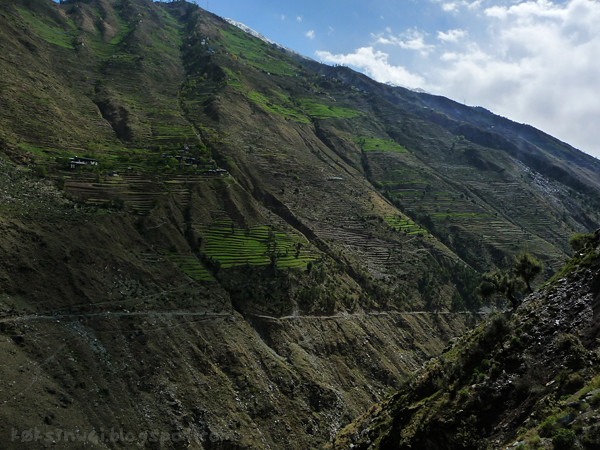 |
| Ever heard of the simile, "as big as a house"? Those white spots dotting the terraced mountainside are houses. |
I got my wish.
This time, the impediment came in the form of a section of the road which had caved under its own weight and tumbled the long way down to the Budhil River at the bottom of the "seemingly bottomless valley". There were no survivors - mainly because no vehicles were ill-fated enough to be travelling on the road at the moment of its structural failure. I am certain that it wouldn't have been a good way to go. Also, it's quite a discomfiting thing to know that at any given second, the very ground beneath the wheels of your bus can just quit its job without so much as a two-week notice.
Examining the disaster area, I realised that the road was built entirely out of shale shards chipped right off the mountain's face and stacked above one another with nary a lick of mortar, glue or phlegm to hold them together (actually, seeing that it's India and its people's love of spitting, I'm not completely ready to rule out phlegm yet), and I'm not talking Incan-style masonry with precisely cut and fitted stone blocks here either. Even to my untrained eye, the shale bits looked like they were simply heaped together higgledy-piggledy, helter-skelter, pell-mell, willy-nilly and all other manners of rhyming reduplicative compound words which convey just how little the engineers and their road builders cared - assuming generously, of course, that an engineer was involved at some stage of the road's construction. Doubtful.
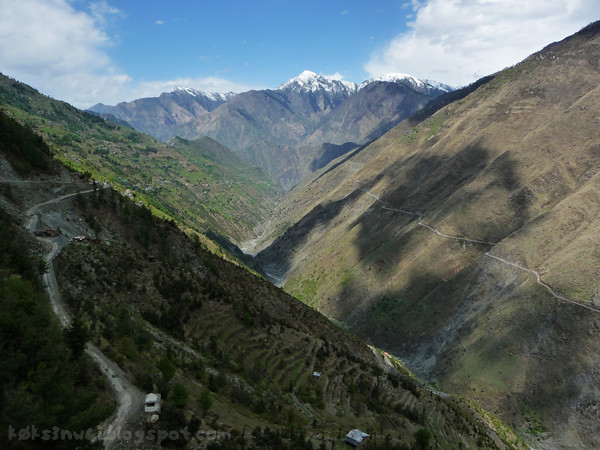 |
| I posted this picture once in an older post. Here it is again for your viewing pleasure. |
After tippy-toeing across the defect in the road and boarding my fourth bus that morning, I was admittedly a lot less confident in my chances of survival but I filed it away in the Hakuna Matata Bobby McFerrin part of my brain. Before too long, Bharmour segued into view without warning from around a rocky promontory like Hilton's Shangri-La walled in by snow-capped mountains and roofed by the cloud-swathed sky. It was an impressive sight to behold indeed.
Who wouldn't want to live in a place like this?
 |
| Bharmour, formerly known as Brahmpura. |
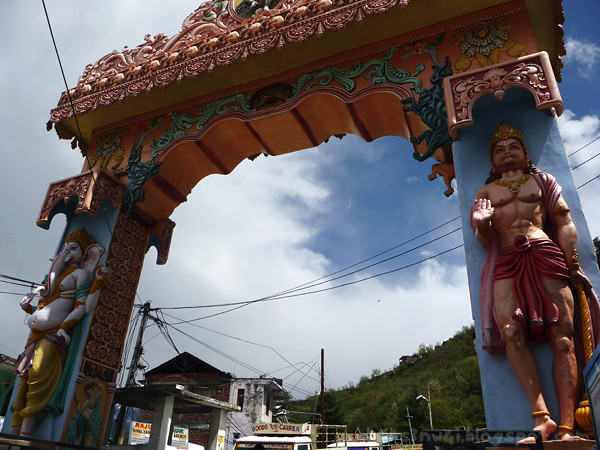 |
| Hanuman says, "S'up?" Ganesha says, "OH HAI." |
So, after a five hour journey totalling four bus rides, two long walks and a perilous jeep run, I finally managed to complete a journey that usually takes only three hours on a single bus. I thought I made pretty good time considering that there were six separate landslides and rockfalls which stood between my destination and I. In a more civilised part of the world, I wouldn't even have a prayer of reaching there because the road would have been closed to the public for daft reasons such as "safety", "surveyance" and "reparation works".
The hills around these parts are prime hiking country but for a day-tripper like me who was a wee bit behind schedule, there was only one point of real interest: the ancient Chaurasi temple compound with its ornately-sculpted stone Śikhara shrines. The absolute centrepiece of the the flagstone square is the monumental 6th century Manimahesh Temple which houses a god's penis within its sanctum sanctorum.
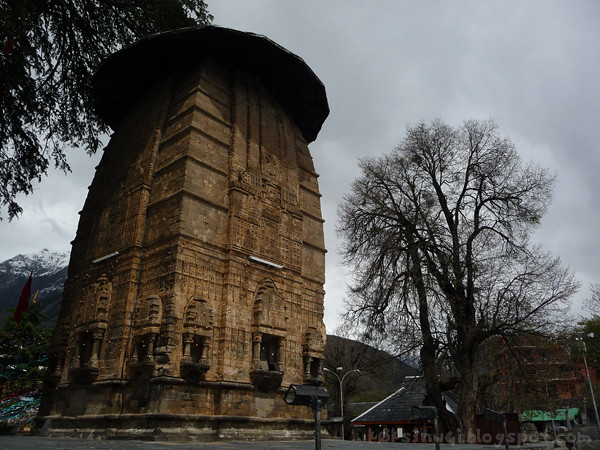 |
| I've seen pictures of it when it was covered in snow. It was breathtaking. |
There were also pesky schoolchildren everywhere. A few public schools operate around the area and students from these institutes frequently use the surplus of free space in the courtyard as outdoor classrooms. So if you plan to visit this location, do remember to carry a can of kids repellant with you.
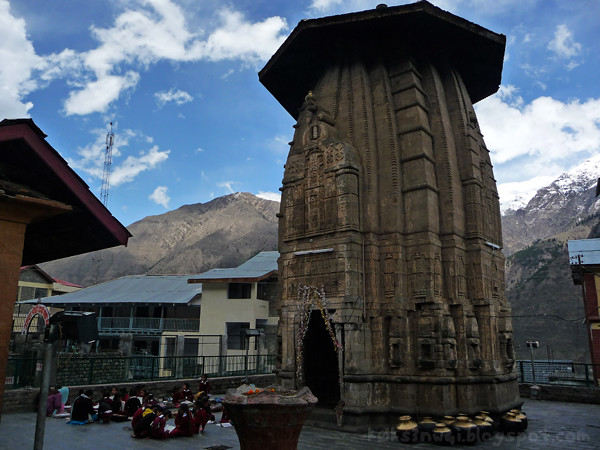 |
| Holy crap! Why didn't my classroom look like this when I was in Primary School?! |
Of course, as beautiful as these old Śikharas are, they cannot hold a candle to the real star attractions of Bharmour: the amazing spectacle of the tremendous skyscraping mountains and the adventure of actually getting there (though I'm fairly certain that the number of hindrances I personally faced was quite immoderate). It was a total treat for me to have to brave the same road back to Chamba later that afternoon.
The bus drivers and conductors however, did not share my enthusiasm for the return journey. My departure was interrupted by a shouting match between the conductors of two different buses trying to decide which team should go to Chamba while the other go wherever else buses from Bharmour have to go - and as far as I could tell, they were trying to settle it by seeing who can spray more saliva into the other guy's face.
It was a local science teacher who explained the nature of the disagreement to me and after a whole day of speaking in single-word utterances, I was glad to have someone I could have an actual conversation with. I don't remember what we talked about, but one thing he said stuck with me:
"It's a good thing that the people of India still fear the gods. It prevents most of them from stealing and robbing others because they think that they are constantly being watched."
"It's a good thing that the people of India still fear the gods. It prevents most of them from stealing and robbing others because they think that they are constantly being watched."
The Battle of the Bus Conductors finally concluded with the younger, less-loud loser and his driver having to shuttle the waiting passengers back to Chamba. Soon, we arrived back at where the road had wimped out and fallen off.
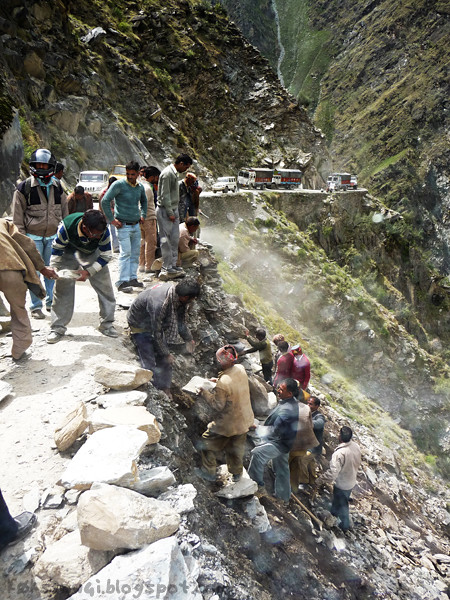 |
| See, I wasn't joking at all about how flimsily the road was constructed. |
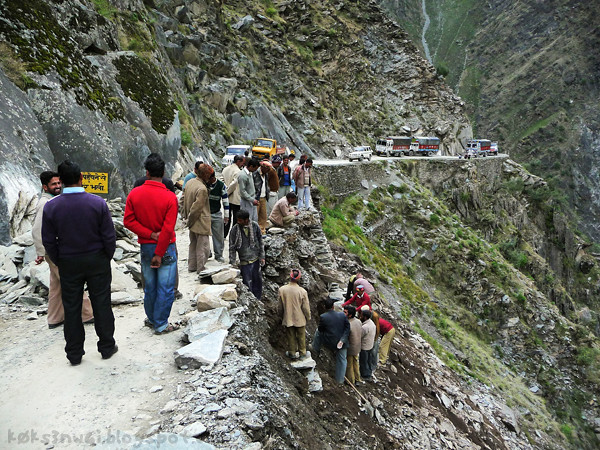 |
| Same scene, but shot further away from the dust cloud. |
This was certainly a first for me: standing quietly by and watching as they sloppily rebuild the road I was going to traverse across in a multi-tonne bus. It's like watching my surgeon read some hastily scrawled instructions on the back of a paper napkin right before he performs a circumcision on my unmentionables. My testicles shrank at the very thought.
It took less than an hour for the road crew and friends to make the passage wide enough to admit the bus I was on, and their haste gave me no reassurance whatsoever. All the passengers (including yours truly) pragmatically made the crossing first, and had the bus rendezvous with us on the other side. It was miracle that the newly assembled road held fast. Thank Lord Shiva and his magic sky dick!
Then it started raining. That's worrying.
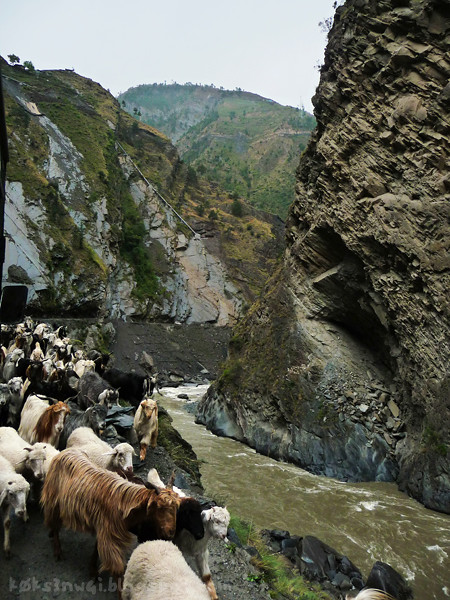 |
| ♪ The goats are going to Bharmour! ♫ |
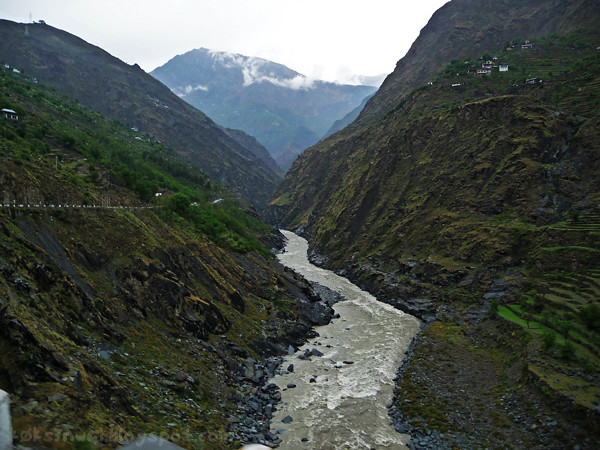 |
| ♪ The humans are going to Chamba! ♫ |
 |
| Well, that looks safe. |
Fortunately, there were no further snags for the rest of way back except for a little stream of silt that we had to ford. It was quite exciting to be honest what with the gushing, grey rainwater eroding the road away from the bottom of our tires and trying to wash our bus down the drink. I wanted to call the Long-Suffering Girlfriend™ to tell her that I love her in case anything should happen to me, but I had very little credit left so I decided to be thrifty and save it instead.
I didn't realise it till much later but seemed that in the few short hours I spent gallivanting in Bharmour, they have managed to clear the detritus from all the rockslides I've ran into earlier that morning. I thought that was bloody efficient, don't you?
I didn't realise it till much later but seemed that in the few short hours I spent gallivanting in Bharmour, they have managed to clear the detritus from all the rockslides I've ran into earlier that morning. I thought that was bloody efficient, don't you?
Anyway, to cap this story off, I arrived in Chamba at dinnertime in the same bus I left Bharmour with, which probably does not happen everyday. I felt unnaturally serene in spite of spending having just spent an entire day experiencing what most people would consider one annoyance after another. I can't really explain it. Some people find inner peace from fishing, prayers or transcendental meditation. For me, it's being out there in the great Himalayan outdoors where the gorgeous landscape is actively trying to kill me.
***
For those interested in making this expedition yourselves, here's a useful sightseer's summary and diagram,
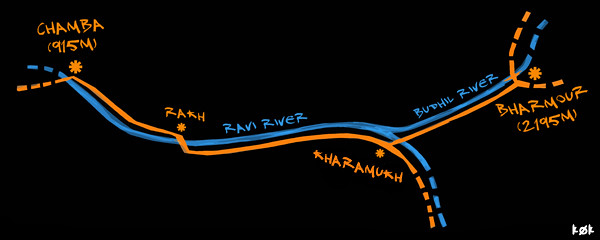 |
| The blue line represents the rivers while the orange one represents the road. |
Travelling from Chamba, the view will be on the right in the first third of the journey up until the village of Rakh. After that, the road crosses the river Ravi, shifting the scenery to the road's left. Even after crossing the Ravi a second time at Kharamukh, the scenery remains on the left as the road accompanies the Budhil River throughout the final third. So, it's advisable to try and bag a seat on the left side of your bus or cab for maximum enjoyment. Me? I switched sides accordingly every time I had to change transports, but don't count on a rockfall to help you with that.
That is all. HopeI have made you jealous with you have enjoyed all my pictures.
P.S. If you felt that the part of the post about the Chaurasi temple complex in Bharmour was a tad brief, it's because I've cannibalised pictures from it for another post.
From Bharmour with amour,
That is all. Hope
P.S. If you felt that the part of the post about the Chaurasi temple complex in Bharmour was a tad brief, it's because I've cannibalised pictures from it for another post.
From Bharmour with amour,
k0k s3n w4i


6 comments:
I wonder how many people die on that road each year...I guess such incidents becomes too commonplace and insignificant to be reported. That old temple looks awesome - I love exploring places like it. The closest I've come to ancient Hindu shrines was at the Prambanan Temple complexes in Yogyakarta, although the main temples were sealed off because of earthquake damage.
omg this seriously reminds me of NZ!! u'd so love NZ man.. awesome pics! :)
In awe of your bravery. I would've turned tail and ran like my life depended on it (probably did). ;)
nicoletta: these sort of temples are a dime a dozen in india, and the region i visited this time doesn't host any of the more impressive ones. and i'm sure the accident rates must be pretty high when parts of the mountain and road can simply fall away. i shudder to think that i actually took the risk.
mg: i'm already sure i'll love nz! problem is it'll be years before i can get there :(
lovealynna: aw, c'mon! don't you think the scenery is worth the teensy risk of loss of life and limbs?! :P
Yeah, that risk is so teensy... compared to those mountains. :D
Oh, and thanks for the FB reply!
Great blog.Fantastic photos. Took me back. I was there in 1983 rocks whistling past my head as I ran. Amazing place!
Post a Comment